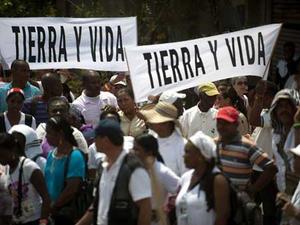The passage of Colombia’s Victims and Land Restitution Law last year looked like a political victory for President Juan Manuel Santos. The legislation formally guarantees compensation and restitution of land to the victims of the country’s drawn out civil war, but transferring the usurped lands to the hands of their rightful owners may prove more difficult than the president had imagined. The groups benefitting from the massive appropriation of more than 14.8 million acres of some of the most fertile lands in the region are not willing to give it away without a serious fight, using legal and, if history has shown anything, illegal violence. In the latest body-count: 66 peasant leaders and land activists have been killed between 2005 and 2012, and more than half of them in the last two years. Threats are increasingly intimidating the popular movements that support the land restitution, while the police and army have been turning a blind eye to those killings; no arrests have been made. This reflects the historic complicity between the military establishment and the perpetrators of violence.
 One of the most outspoken Senators in Colombia on the subject of agrarian reform, Jorge Enrique Robledo, recently raised questions about the free trade agreements (in reference to agreements with Canada and the United States) that endorse the idea that land must be used efficiently based on large-scale commercial agriculture if Colombia is to compete in a global market. The peasant economy and small production do not figure prominently into this line of thinking. In this context, Robledo pointed out that the legislation amended Law 160, initially designed to prohibit granting public lands to local and foreign investors, which will most likely promote large-scale commercial agriculture in the region. Robledo concluded that President Santos wants to take the regressive step to transform the peasants into sharecroppers rather than independent farmers. If Senator Robledo’s assessment and reading of the situation is accurate, then the future of this law will reinforce a model that will neither foster development nor peace, and gives scant hope for land restitution for the hundreds of thousands whose properties were usurped over the last two decades. But this law did have one unforeseen consequence: raising expectations.
One of the most outspoken Senators in Colombia on the subject of agrarian reform, Jorge Enrique Robledo, recently raised questions about the free trade agreements (in reference to agreements with Canada and the United States) that endorse the idea that land must be used efficiently based on large-scale commercial agriculture if Colombia is to compete in a global market. The peasant economy and small production do not figure prominently into this line of thinking. In this context, Robledo pointed out that the legislation amended Law 160, initially designed to prohibit granting public lands to local and foreign investors, which will most likely promote large-scale commercial agriculture in the region. Robledo concluded that President Santos wants to take the regressive step to transform the peasants into sharecroppers rather than independent farmers. If Senator Robledo’s assessment and reading of the situation is accurate, then the future of this law will reinforce a model that will neither foster development nor peace, and gives scant hope for land restitution for the hundreds of thousands whose properties were usurped over the last two decades. But this law did have one unforeseen consequence: raising expectations.
This debate reenergized activists, culminating in the Hundred-Thousand strong Marcha Patriotica in Bogota in April. Despite the rise of this movement, the law has also reactivated reactionary forces, which are going on the offensive by increasing their targeted killings and intimidation by forming the Ejército contra la Restitución (Army Against Restitution).The emergence of such a group reflects the rising tension between the energized peasantry and oppositional groups such as paramilitaries (such as Urabenos, Rastrojos) that are being supported by some large landowners, large scale cattle ranchers, agribusinesses, land speculators, and multinational corporations.
For more from Nazih Richani's blog, Colombian Cuadernos, visit nacla.org/blog/cuadernos-colombianos, or see the NACLA Report July/August 2009, "Coercion Incorporated: Paramilitary Colombia." Subscribe to NACLA

